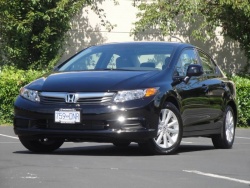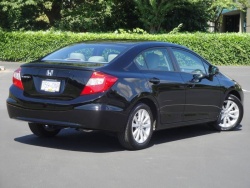Driving impressions
2012 Honda Civic EX sedan. Click image to enlarge |
With the same horsepower and torque as last year’s model, the new Civic sedan doesn’t make any big gains in performance, but I did detect a slight reduction in engine noise which made highway cruising more comfortable. The engine revs at just 2,000 rpm in top gear at 100 km/h. Still, with its competitors bringing out more powerful four-cylinder engines, the Civic is being left behind in the performance arena. The 2011 Hyundai Elantra sedan, for example, with its 148-horsepower 1.8-litre engine and six-speed automatic transmission, is quicker from 0 to 60 mph according to Consumer Reports (9.5 vs 9.9 seconds) and offers better fuel economy.
Civic drivers who want to save more fuel and reduce emissions can press the green button on the Civic’s dash to activate Econ mode. This saves fuel by cutting back the throttle responsiveness, allowing the transmission to shift up sooner and preventing it from shifting down as quickly. In Econ mode, performance could be described as lethargic, and requires a cautious driving style to compensate for its slow acceleration – for example, you learn not to turn right in front of fast-moving vehicles and expect to get out of their way.
The Civic’s optional five-speed automatic transmission (n/a on DX, optional on LX and EX, standard on EX-L) is responsive and changes quickly and smoothly. Applying the brakes while going downhill causes the transmission to shift down one or two gears for engine braking, and with the foot off the pedal, the fuel injectors shut off so that it doesn’t use any more fuel while revving higher. Shifting from D to D3 requires pressing a button on the shift lever which prevents inadvertently driving around in third gear – earlier Honda transmissions slipped into D3 by just pulling on the lever. Unlike some competitor’s manumatics, the Civic’s five-speed automatic transmission doesn’t include a manual mode.
  2012 Honda Civic EX sedan. Click image to enlarge |
I like this transmission, but I have to wonder why Honda didn’t upgrade to a six-speed automatic like many of their competitors have. It would have improved fuel economy even more.
With its fully independent suspension, the Civic sedan is still a nimble handler, but a slight softening of the suspension provides a more comfortable ride which I found to be a benefit as roads deteriorate. My test car had Continental ContiPro contact 205/55R-16-inch all seasons which proved grippy in the dry but emitted some road noise at highway speeds. The Civic could use more sound insulation in the wheelwells, as could most cars.
All 2012 Civics now include Honda’s next-generation Vehicle Stability Assist system with Traction Control and Brake Assist which automatically intervenes in case of a loss of traction, directional control, or panic braking. Previously, this was only available on EX-L, Si and Hybrid models. Statistics show that these automatic systems save lives.
The Civic’s revised “Motion-Adaptive Electric Power Steering (EPS)” is easy on the arms, turns quickly, and has a tight 10.7 metre (35.4 ft.) turning circle, but the steering feels less connected with the road. The Civic’s slightly shorter wheelbase should contribute to improved maneuverability, but I couldn’t detect a noticeable difference. I did like the Civic’s new smaller steering wheel.
Driver visibility is good: new larger front quarter windows and slimmer windshield pillars contribute to better visibility when turning. However, the three rear head restraints and the high rear trunk lid obscure the view to the rear. Rear parking sensors or a rearview camera would be a useful addition to the Civic’s options list.
The Civic EX and EX-L have four wheel disc brakes with anti-lock and Brake Assist for emergencies, and I found pedal feel good and braking distances in the dry commendably short. Civic DX and LX models have rear drum brakes.











